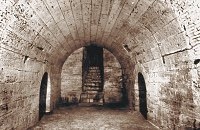
Image courtesy of the Soprintendenza
per i Beni Archeologici dell'Umbria
This chamber tomb now forms the crypt of the church of San Manno, outside Perugia. It was discovered many centuries ago, and no information survives as to its original contents. Its Etruscan provenance has sometimes been doubted because of the sophistication of the vaulting of its roof, but the inscription (see below) that was uncovered on the left wall confirms it. The tomb seems to have been in use from the late 3rd to the early 1st century BC.
The tomb is in the form of a Greek cross. The main, rectangular room is dome-vaulted and faced with travertine blocks that have been laid without mortar. Two small vaulted chambers open symmetrically at the sides. The original entrance was on the side opposite the stairs that now provide access.
The hypogeum seems to have inspired the design of the Ipogeo di Colle (3rd – 1st centuries BC), outside Bettona.
Inscription
An important 3-line inscription has been uncovered above the entrance to the left cell:
cehen óuθi hinθiu θues óians etve θaure lautnescle careóri
aules larθial precuθurasi larθialióvle cestnal
clenarasi eθ fanu lautn precus ipa murzua cerurum ein heczri tunur clutiva zelur
This reveals that the tomb belonged to the brothers Avle and Larth Precu, the sons of Larth and his wife, a lady from the Cestna family. The last part of the inscription seems to prescribe the way that the tomb is to be used.
The inscription is put into context in the page on Etruscan Inscriptions after 295BC.
[The tomb can be visited on request: telephone 075 505 7190 (Opera Agnus Dei).]



